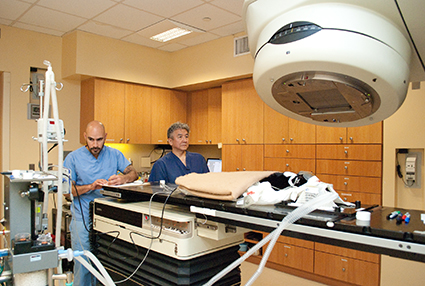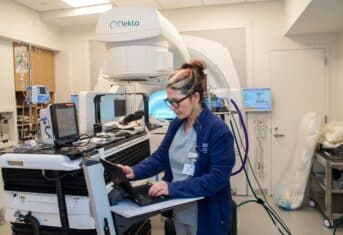The Difference Between Diagnostic Radiology, Radiation Therapy and Interventional Radiology

The Difference Between Diagnostic Radiology, Radiation Therapy and Interventional Radiology
At first glance, these three disciplines within veterinary medicine seem pretty much the same, but at the Animal Medical Center, diagnostic radiology, radiation therapy, and interventional radiology represent three different groups of veterinarians with three very different sets of background and training. What ties these three disparate groups together is their use of radiation to diagnose and treat disease.
Diagnostic Radiology
These days you are more likely to find a Department of Diagnostic Imaging in a hospital than a Radiology Department. Radiology is an older term, used when x-rays were the only testing modality using radiation available in medicine. Today, AMC’s Diagnostic Imaging Service uses not only traditional x-rays but also ultrasound, computed tomography (CT) scans, and magnetic resonance imaging (MRI) in the diagnostic evaluation of patients. AMC’s Diagnostic Imaging Service also has a fluoroscopy unit, which is like a video x-ray. This machine allows us to watch bodily functions like blood flow or swallowing in real time. To see an example of fluoroscopy, read about Molly the Ganaraskan. Every veterinarian at AMC depends on our diagnostic imaging team for their expertise in imaging sick pets and helping us to make an accurate diagnosis.
Radiation Therapy
A very accurate description, AMC’s Radiation Oncology Service uses radiation to treat tumors. Specifically, we have a linear accelerator (linac), a giant machine that creates various types of radiation depending on patient needs. Our state-of-the-art linac can make electrons for superficial treatments, produce high energy pinpoint beams for stereotactic radiosurgery, and stereotactic body radiation therapy. Diagnostic Imaging’s CT scanner interfaces with Radiation Oncology’s 3-D computer planning system. The interface allows the linac’s multileaf collimator to sculpt the radiation beam to precisely target the tumor being treated. The veterinarians working in radiation therapy have training in both the physics of radiation as well as the management of cancer.
Interventional Radiology
Specialists in interventional radiology use minimally invasive techniques to make image-guided diagnoses and also deploy high tech treatments for a variety of diseases. Using a range of techniques which rely on the use of images generated by diagnostic radiology equipment such as fluoroscopy, ultrasound, CT scan, or MRI imaging, the interventional radiologist precisely targets various organs with treatments such as stents, occluders and medications. Watch a video where AMC’s interventional radiology team uses fluoroscopy to close off abnormal blood vessels in the liver. The veterinarians in our Interventional Radiology Service have diverse backgrounds in surgery, internal medicine plus specialized training to use minimally invasive equipment.
Linked together by their use of radiation as a diagnostic and therapeutic tool, diagnostic radiology, radiation therapy and interventional radiology are just a few of the highly trained specialists at AMC working to make sick pets healthy again.

































